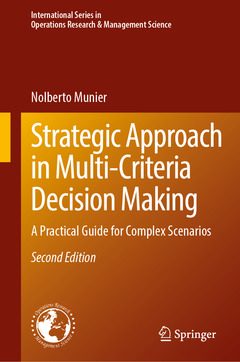Description
Strategic Approach in Multi-Criteria Decision Making (2nd Ed., 2nd ed. 2024)
A Practical Guide for Complex Scenarios
International Series in Operations Research & Management Science Series, Vol. 351
Author: Munier Nolberto
Language: English
401 p. · 15.5x23.5 cm · Hardback
Description
/li>Contents
/li>Biography
/li>Comment
/li>
This book examines multiple criteria decision making (MCDM) and presents the Sequential Iterative Modelling for Urban Systems (SIMUS) as a method to be used for strategic decision making. It emphasizes the necessity to take into account aspects related to real world scenarios and incorporating possible real-life aspects for modelling. The book also highlights the use of sensitivity analysis and presents a method for using criteria marginal values instead of weights, which permits the drawing of curves that depicts the variations of the objective function due to increments/decrements of criteria values. In this way, it also gives quantitative values of the objective function allowing stakeholders to perform a comprehensive risk analysis for a solution when it is affected by exogenous variables.
Strategic Multi-Criteria Decision Making: A Practical Guide for Complex Scenarios is divided into four parts. Part 1 is devoted to exploring the history and development of the discipline and the way it is currently used. It highlights drawbacks and problems that scholars have identified in different MCDM methods and techniques. Part 2 refers to what can be done using the MCDM process. Part 3 proposes the SIMUS method as a strategic procedure to deal with MCDM problems, and addressing how to approach complicate scenarios. Part 4 is entirely devoted to support practitioners through more than 100 questions a user may ask, and their corresponding answers, as well as a collection of solved six complex real-life scenarios. The decision-making process can be a complex task, especially with multi-criteria problems. With large amounts of information, it can be an extremely difficult to make a rational decision, due to the number of intervening variables, their interrelationships, potential solutions that might exist, diverse objectives envisioned for a project, etc. The SIMUS method has been designed to offer a strategy to help organize, classify, and evaluate this information effectively.
Nolberto Munier is an Associate Researcher at INGENIO – Polytechnic University of Valencia, Spain. A mechanical engineer with a Ph.D. in project management, he is also the author of more than 30 technical books, mainly on operations research and project management, and a reviewer of technical articles for several journals. His research focuses on decision-making methods and sensitivity analysis.




